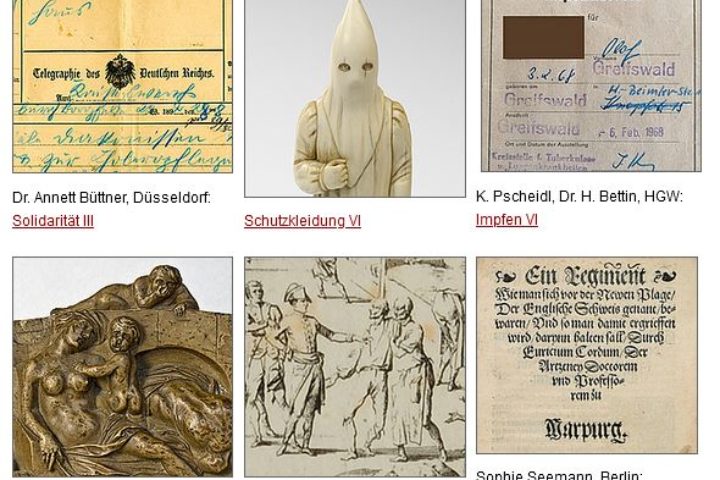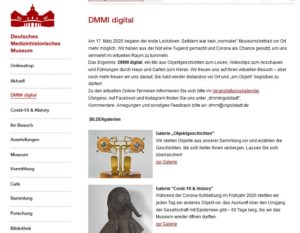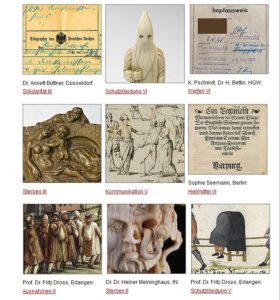February 21, 2023
The COVID19 Challenge. Museums in Times of Crises – Results of the Solidarity Project of AVICOM, MPR & ICOM Germany – With Best Practice Examples Publication

Gallery “COVID-19 & History”, Deutsches Medizinhistorisches Museum Ingolstadt
When it comes to finding out about something, the internet is by far the most important tool today. More than 75 per cent of Internet users first inform themselves on the Internet – about news, laws and guidelines, products, services, people, culture, travel destinations, places of interest … and visit corresponding websites for this purpose. Here, findability, appeal to the user, content, form and user-friendliness determine the degree of positive, convincing perception and, as a result, the actual use of what is offered. In this context, the good design of the homepage as the start page of a website plays a very decisive role. Homepages are business cards, the intro to websites, with which persons and institutions present themselves, (let themselves be) identified – accessible seven days a week, 24 hours a day from anywhere in the world, provided there is no technical malfunction.
To be able to communicate around the clock, just in time and globally, according to topic and target group as needed, and also barrier-free: that is the benefit of social media. They offer a platform for news, for obtaining opinions and suggestions, for dialogue and discourse, they create new contacts and serve as a means of “customer loyalty”.
It is a truism that websites and social media have long since become indispensable means of communication, information and marketing also for cultural institutions, heritage sites and museums. Even if the use of these means still shows significant differences in a global comparison: If, for example, in Germany in 2018, i.e. before the start of the Corona pandemic, around 95 per cent of all museums were present either via their own homepage or via another website (1), this may be in line with the European average. In any case, the percentage value differs significantly from the internet presence of museums in developing and emerging countries on other continents. The transferability of the percentages of social media use of German museums to other countries is equally questionable: in 2018, 44.7 percent posted on Facebook, 17.4 percent on Instagram and 10.3 percent on Twitter. (2)
For the pandemic year 2020, in the first months of which there were still no regulations for the operation of public cultural institutions and thus impairments to their operations, a statistical survey shows an increase in digital activities for around 40 per cent of German museums. No increase was reported by about 48 per cent of the museums, and about 10 per cent gave no information. However, the non-increase at those 48 percent of museums cannot be interpreted: It is possible that many museums were already well positioned digitally before the pandemic.
That the increase in other museums is directly related to the negative impact of the pandemic on public, physical museum use is suggested by data on the nature of the increase: Online exhibitions increased by 20.7 per cent, special offers such as exploratory games by 33.4 per cent, shifting of planned activities to the internet by 35.6 per cent and the development of digital media and content in general by 53.4 per cent. An increase in the use of social media was reported by 68.1 per cent of museums.(3)
But what does all this say about the quality of cultural institutions’ digital communication and interaction with the public? What about the public’s perception, their reaction?
This study has examined the digital presences and activities of more than 150 museums in times of the pandemic. With its innovative methodology of a multi-layered cross-diagnosis and evaluation, it was possible to evaluate the digital presence of each museum in a score and, which was ultimately the important goal of the study, to identify best practice examples as signposts for successful digital communication of cultural institutions.
YouTube Video “The end of the tancs?” on the war in Ukraine, Deutsches Panzermuseum Munster
Beyond the text version presented here in the three ICOM languages, the results of the research can be analysed in depth – through links and interactive tools.
The ICOM committees AVICOM and MPR – both of whom share an interest in media communication of museums and culture – are grateful to ICOM for granting this unique project and thus also financial support, without which the project could not have been successfully carried out in this dimension. AVICOM and MPR are also grateful to the German ICOM National Committee, which successfully accompanied the application for the project and its promotion – not least in a Joint Session at the ICOM General Conference in Prague 2022, which was marked by great resonance. Very special thanks, however, go to Michael Eulenstein, a young scientist from the University of Hildesheim/Germany. In constant close scientific and methodological coordination with us, he carried out this study with unbelievable commitment, impressive creativity and an extraordinary sense of the essential. The results are impressive!
1) Staatliche Museen zu Berlin – Preußischer Kulturbesitz. Institut für Museumskunde (Ed.): Statistische Gesamterhebung an den Museen der Bundesrepublik Deutschland für das Jahr 2018. Including an English Summary. Berlin 2019 (= Materialien aus dem Institut für Museumsforschung, Heft 73)
2) Ibid.
3) Staatliche Museen zu Berlin – Preußischer Kulturbesitz. Institut für Museumskunde (Ed.): Statistische Gesamterhebung an den Museen der Bundesrepublik Deutschland für das Jahr 2020. Including an English Summary. Berlin 2022 (= Materialien aus dem Institut für Museumsforschung, Heft 76)
Michael H. Faber
Here you will find the complete documentation:
https://linktr.ee/covid19challenge


